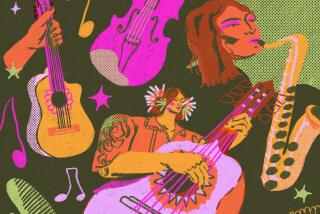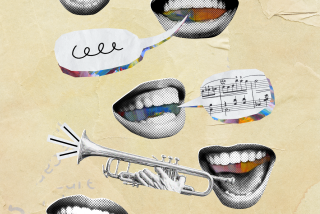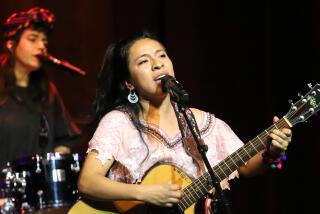A SOUND CULTURE : Instruments of Ancient and Modern Civilization are Revealed in ‘Music of the Maya’
On the surface, creating a museum exhibit about music would seem to make about as much sense as, well, recording an album about sculpture.
But in the case of “Music of the Maya,” opening Saturday at the Fullerton Museum Center, a museum setting is an ideal way to tell the history of Mayan music, and to explain how it fits into Mayan life today, organizers say.
“Through the music you can share Mayan culture with people, because it really touches all facets of their lives,” said Jeri Corbin of San Diego’s Museum of Man, which helped create “Music of the Maya.”
Ruins of fantastic cities built by ancient Mayans dot the Yucatan Peninsula in Central America, but it is not a dead society; on the contrary, Indian groups of Mayan ancestry continue a vibrant and flourishing culture in the central highlands of Guatemala and in parts of southern Mexico.
Much of Mayan culture today is a distinctive and complex blend of Catholicism and traditional beliefs and practices. Outside the region, contemporary Mayans are known mostly for their wildly colorful weavings, but music also is an integral facet of the ceremonies and rituals that are part of everyday life.
Corbin was traveling in Guatemala in 1985 when she first visited Casa K’ojom, a museum that had just opened in the highland city of Antigua, Guatemala’s former colonial capital. Casa K’ojom is dedicated to the preservation of Mayan musical history from pre-Columbian times to the present.
“I handle the traveling exhibits here at the (Museum of Man), so I’m always looking for something we can do,” Corbin said. She proposed the idea of creating an exhibit on Mayan music with Casa K’ojom, and the exhibit opened in 1989. It has been seen in San Diego, Texas and Illinois. The instruments belong to the Museum of Man, but the rest of the exhibit will go to Guatemala after its stay in Fullerton.
The exhibit includes Mayan musical instruments, as well as traditional costumes, dance masks, photographs and other graphics, paintings by Miguel Chavez (a Tzutuhil Maya) and a video of ceremonies and musical performances taken by Casa K’o jom director Samuel Franco, who designed the exhibit.
Music has been a part of daily Mayan life since before the Spanish arrival, Corbin said, particularly flutes and drums. Instruments have changed since then: string and brass instruments, now used widely, are European introductions. Even the gourd marimba, the instrument probably most associated with Guatemala, is not native, having originated in Africa.
In addition to the new instrumentation, the other major change in Mayan music that came with the Spanish was Catholicism. Traditional Mayan religious practices were overlaid onto the Catholic faith, resulting in elaborate ceremonies and rituals honoring specific saints.
Some of these ceremonies have remained largely unchanged for hundreds of years, but in recent years traditional Mayan culture has been eroded by a widespread evangelical movement. While the Catholics have been largely tolerant of traditional practices, under the new churches the Mayans are told such practices are paganish.
Moreover, since the early ‘80s, Mayans have often been caught between the government and a rural guerrilla movement, resulting in persecution and even widespread massacre.
“The ceremonies are being lost,” Corbin said. Franco created Casa K’ojom in response, as a way of preserving Mayan musical traditions. “Music of the Maya” is designed to recreate a day of ritual in the life of the contemporary Maya, in addition to exploring its history.
The exhibit is also a tour of traditional Mayan villages and towns in Guatemala and Mexico, and it chronicles the struggle to preserve their way of life.
‘Music of the Maya’ on Tour
Samuel Franco, director of the Casa K’ojom museum in Guatemala, will conduct two tours of “Music of the Maya” at the Fullerton Museum Center on Saturday, one for the general public (at 1 p.m.) and one for museum members (at 7 p.m.). The public is also invited to the exhibit’s opening reception, beginning at 8 p.m.
Tickets for the 1 p.m. tour are $5. Phone reservations must be received by Friday. Information: (714) 738-6545.
More to Read
Sign up for Essential California
The most important California stories and recommendations in your inbox every morning.
You may occasionally receive promotional content from the Los Angeles Times.










